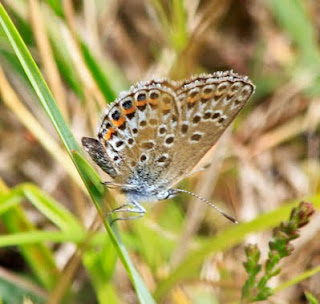17th December
We met in Maiden Lane and walked out to Oxey Lake then around Normandy Lagoon. The area always produces a variety of waterfowl at this time of year and as always didn't disappoint. We started quickly with a Spotted Redshank calling overhead as we left the cars. Little Egret, Redshank, Little Grebe, Coots and Mallards on 8 Acre Pond soon followed. Oxey Lake was absent of all species except two Shoveler but as we scanned we had fly pasts from three Black-tailed Godwit, two Oystercatcher, couple of Curlew and thirteen Lapwing.
 |
| Little Grebe 8 Acre Pond © Nick Hull |
Normandy lagoon alway gives the advantage of going through the individual species and discussing identification points and features. Of note here we found Greenshank, Avocets another Spotted Redshank, Dunlin, Teal, Pintail, Wigeon, Tufted Duck, Red-breasted Mergansers and a Kingfisher. Walking around and looking over the Solent we added Great Crested Grebe, Grey Plover more Dunlin and Brent Geese. All of a sudden I heard two high pitched calls and looking to my left saw a Kingfisher then another chasing, they flew past us turned and came back around us and away across Oxey Lake, then a few minutes later one of the same or another flew in and landed on the marsh fence right in front of us giving fantastic views. As we started our return towards the cars we had a Dartford Warbler followed shortly after by a pair of Stonechat, Reed Bunting and Linnets just as the rain started.
Walking back along the lane we added many woodland and garden species and a handful of winter thrushes mainly Redwing with Blackbirds and Song Thrush. Unfortunately the rain started to increase and and we picked up the pace to get back to the cars before getting to wet. We ended two and a half hour walk with 59 species.
20th December
This morning we met at Holton Lee which borders my local patch which lies the other side of Lytchett Bay, it has the advantage of being on the edge of the Wareham Channel there is also Woodland and Heathland areas. We headed down to the hide in the woodland and we stayed for some time watching a good variety of bird comings and goings. Great, Coal and Blue Tit made up the majority but Moorhen, Pheasant, Jackdaw and at least three Great Spotted Woodpecker were visiting. We heard a Raven but couldn't find it and a Sparrowhawk zipped through. We even had a small herd of Sika out in the reedbed one of which was white. After a while we were seeing no new species so we moved off to the new scrape hide which looks north over the reedbeds and the Sherford River toward RSPB Lytchett Fields. The scrape was made back in the summer and a the hide repositioned to give good views over the area. En-route we saw a small flock of Redwing, Mistle Thrush a single Chiffchaff and a small number of Goldcrest. On reaching the hide I didn't expect much to be there being the habitat was so fresh and new. At first look it appeared empty but after a short wait a beautiful Greenshank flew it and paraded in front of the hide shortly after a Green Sandpiper flew in for a short while, then a Kingfisher came in and gave us some excellent views. Out in the bay we could see good numbers of Wigeon, fewer Teal, Mute Swan, Shelduck and a distant Kestrel.
We made our way across the heath seeing a Buzzard lift off and climb away, we continued on and crossed the fields to the Wareham Channel here we added Goldeneye, Cormorants, Great Crested Grebe, Teal, Wigeon, Curlew and Redshank. It was Mick who found a raptor sat on a post which turned out to be a female type Marsh Harrier, and a small flock of Long-tailed Tit filtered by.































